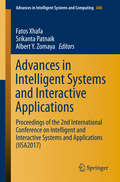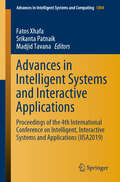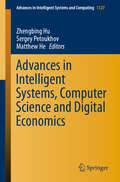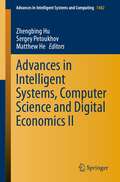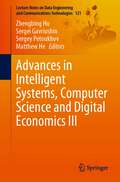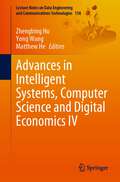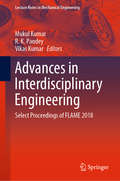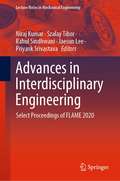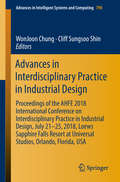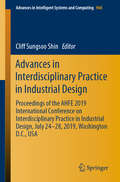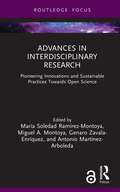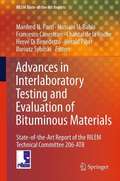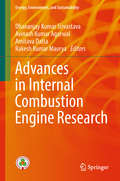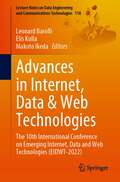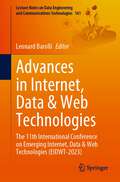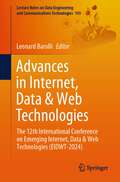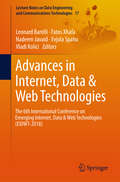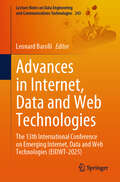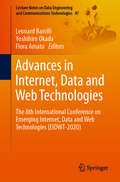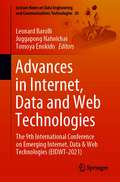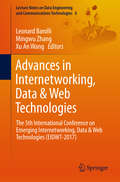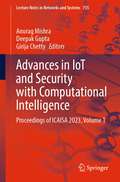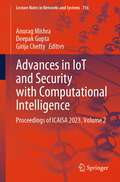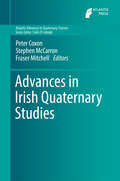- Table View
- List View
Advances in Intelligent Systems and Interactive Applications: Proceedings of the 2nd International Conference on Intelligent and Interactive Systems and Applications (IISA2017) (Advances in Intelligent Systems and Computing #686)
by Albert Y. Zomaya Fatos Xhafa Srikanta PatnaikThis book presents research papers from diverse areas on novel Intelligent Systems and Interactive Systems and Applications. It gathers selected research papers presented at the 2nd International Conference on Intelligent and Interactive Systems and Applications (IISA2017), which was held on June 17-18, 2017 in Beijing, China. Interactive Intelligent Systems (IIS) are systems that interact with human beings, media or virtual agents in intelligent computing environments. The emergence of Big Data and the Internet of Things have now opened new opportunities in both academic and industrial research for the successful design and development of intelligent interactive systems. This book explores how novel interactive systems can be used to overcome various challenges and limitations previously encountered by human beings by combining machine learning algorithms and the analysis of recent trends. The book presents 125 contributions, which have been categorized into seven sections, namely: i) Autonomous Systems; ii) Pattern Recognition and Vision Systems; iii) E-Enabled Systems; iv) Mobile Computing and Intelligent Networking; v) Internet and Cloud Computing; vi) Intelligent Systems, and vii) Various Applications. It not only offers readers extensive theoretical information on Intelligent and Interactive Systems, but also introduces them to various applications in different domains.
Advances in Intelligent Systems and Interactive Applications: Proceedings of the 4th International Conference on Intelligent, Interactive Systems and Applications (IISA2019) (Advances in Intelligent Systems and Computing #1084)
by Madjid Tavana Fatos Xhafa Srikanta PatnaikThis edited book is based on the research papers presented at the 4th International Conference on Intelligent, Interactive Systems and Applications (IISA2019), held on June 28–30, 2019 in Bangkok, Thailand. Interactive intelligent systems (IIS) are systems that interact with human beings, media or virtual agents in intelligent computing environments. This book explores how novel interactive systems can intelligently address various challenges and also limitations previously encountered by human beings using different machine learning algorithms, and analyzes recent trends. The book includes contributions from diverse areas of IIS, here categorized into seven sections, namely i) Intelligent Systems; ii) Autonomous Systems; iii) Pattern Recognition and Computer Vision; iv) E-Enabled Systems; v) Internet & Cloud Computing; vi) Mobile & Wireless Communication; and vii) Various Applications. It not only presents theoretical knowledge on the intelligent and interactive systems but also discusses various applications pertaining to different domains.
Advances in Intelligent Systems for Sustainable Agriculture: Proceedings of the 3rd International Conference, ICISA 2024 (Lecture Notes in Networks and Systems #1201)
by Anand J. Kulkarni Mostafa Hajiaghaei-KeshteliThis book presents the select proceedings of the 3rd International Conference on Intelligent Systems and Applications 2023. The theme of this conference is ‘Intelligent Systems for Agricultural Applications'. It covers the topics of intelligent systems in multiple aspects such as sustainable crop production, weather prediction, post-harvest management and agro-processing, digitalization and automation of agri equipment, agriculture warehouse and supply chain management, yield prediction, and quality assessment. The book is useful for researchers and professionals interested in the broad field of artificial intelligence and machine learning.
Advances in Intelligent Systems, Computer Science and Digital Economics (Advances in Intelligent Systems and Computing #1127)
by Sergey Petoukhov Matthew He Zhengbing HuThis book comprises high-quality, refereed research papers presented at the 2019 International Symposium on Computer Science, Digital Economy and Intelligent Systems (CSDEIS2019): The symposium, held in Moscow, Russia, on 4–6 October 2019, was organized jointly by Moscow State Technical University and the International Research Association of Modern Education and Computer Science. The book discusses the state of the art in areas such as computer science and its technological applications; intelligent systems and intellectual approaches; and digital economics and methodological approaches. It is an excellent reference resource for researchers, undergraduate and graduate students, engineers, and management practitioners interested in computer science and its applications in engineering and management.
Advances in Intelligent Systems, Computer Science and Digital Economics II (Advances in Intelligent Systems and Computing #1402)
by Sergey Petoukhov Matthew He Zhengbing HuThis book comprises high-quality refereed research papers presented at The Second International Symposium on Computer Science, Digital Economy and Intelligent Systems (CSDEIS2020), held in Moscow, Russia, on December 18–20, 2020, organized jointly by Moscow State Technical University and the International Research Association of Modern Education and Computer Science. The topics discussed in the book include state-of-the-art papers in computer science and their technological applications; intelligent systems and intellectual approaches; digital economics and methodological approaches. It is an excellent source of references for researchers, graduate students, engineers, management practitioners, and undergraduate students interested in computer science and their applications in engineering and management.
Advances in Intelligent Systems, Computer Science and Digital Economics III (Lecture Notes on Data Engineering and Communications Technologies #121)
by Sergey Petoukhov Matthew He Zhengbing Hu Sergei GavriushinThe book comprises high-quality refereed research papers presented at the Third International Symposium on Computer Science, Digital Economy, and Intelligent Systems (CSDEIS2021), held in Moscow, Russia, on December 25-26, 2021, organized jointly by the Mechanical Engineering Research Institute of the Russian Academy of Sciences,Moscow State Technical University, and the International Research Association of Modern Education and Computer Science. The topics discussed in the book includes state-of-the-art papers in computer science and their technological applications; intelligent systems and intellectual approaches; digital economics and methodological approaches. It is an excellent source of references for researchers, graduate students, engineers, management practitioners, and undergraduate students interested in computer science and its applications in engineering and management.
Advances in Intelligent Systems, Computer Science and Digital Economics IV (Lecture Notes on Data Engineering and Communications Technologies #158)
by Matthew He Yong Wang Zhengbing HuThis book comprises high-quality peer-reviewed research papers presented at the 4th International Symposium on Computer Science, Digital Economy and Intelligent Systems (CSDEIS2022), held in Wuhan, China, from November 11–13, 2022, organized jointly by the Wuhan University of Technology, Hubei University of Technology, Wuhan University of Science and Technology, the Polish Operational and Systems Society, and the International Center of Informatics and Computer Science (ICICS). The topics discussed in the book include state-of-the-art papers in computer science and their technological applications; intelligent systems and intellectual approaches; digital economics and educational approaches. It is an excellent source of references for researchers, graduate students, engineers, management practitioners, and undergraduate students interested in computer science and its applications in engineering and management.
Advances in Interdisciplinary Engineering: Select Proceedings of FLAME 2018 (Lecture Notes in Mechanical Engineering)
by Vikas Kumar Mukul Kumar R. K. PandeyThis book presents select proceedings of the International Conference on Future Learning Aspects of Mechanical Engineering (FLAME 2018). The book discusses interdisciplinary areas such as automobile engineering, mechatronics, applied and structural mechanics, bio-mechanics, biomedical instrumentation, ergonomics, biodynamic modeling, nuclear engineering, agriculture engineering, and farm machineries. The contents of the book will benefit both researchers and professionals.
Advances in Interdisciplinary Engineering: Select Proceedings of FLAME 2020 (Lecture Notes in Mechanical Engineering)
by Niraj Kumar Rahul Sindhwani Szalay Tibor Jaesun Lee Priyank SrivastavaThis book comprises the select proceedings of the International Conference on Future Learning Aspects of Mechanical Engineering (FLAME) 2020. This volume focuses on several emerging interdisciplinary areas involving mechanical engineering. Some of the topics covered include automobile engineering, mechatronics, applied mechanics, structural mechanics, hydraulic mechanics, human vibration, biomechanics, biomedical Instrumentation, ergonomics, biodynamic modeling, nuclear engineering, and agriculture engineering. The contents of this book will be useful for students, researchers as well as professionals interested in interdisciplinary topics of mechanical engineering.
Advances in Interdisciplinary Practice in Industrial Design: Proceedings of the AHFE 2018 International Conference on Interdisciplinary Practice in Industrial Design, July 21-25, 2018, Loews Sapphire Falls Resort at Universal Studios, Orlando, Florida, USA (Advances in Intelligent Systems and Computing #790)
by Cliff Sungsoo Shin WonJoon ChungThis book provides readers with a snapshot of cutting-edge methods and procedures in industrial design, with a particular focus on human-centered and user-experience design, service design, sustainable design and applications of virtual & augmented reality. Reporting on both theoretical and practical investigations aimed at improving industrial design through interdisciplinary collaboration, it covers a wide range of topics – from design strategies to product research and planning, exhibit design, as well as new materials and color research. Based on the AHFE 2018 International Conference on Interdisciplinary Practice in Industrial Design, held on July 21–25, 2018, in Orlando, Florida, USA, the book offers a timely guide for industrial designers, production engineers and computer scientists.
Advances in Interdisciplinary Practice in Industrial Design: Proceedings of the AHFE 2019 International Conference on Interdisciplinary Practice in Industrial Design, July 24-28, 2019, Washington D.C., USA (Advances in Intelligent Systems and Computing #968)
by Cliff Sungsoo ShinThis book provides readers with a snapshot of cutting-edge methods and procedures in industrial design, with a particular focus on human-centered and user-experience design, service design, sustainable design and applications of virtual & augmented reality. Reporting on both theoretical and practical investigations aimed at improving industrial design through interdisciplinary collaboration, it covers a wide range of topics – from design strategies to product research and planning, exhibit design, as well as new materials and color research. Based on the AHFE 2019 International Conference on Interdisciplinary Practice in Industrial Design, held on July 24–28, 2019, Washington D.C., USA, the book offers a timely guide for industrial designers, production engineers and computer scientists.
Advances in Interdisciplinary Research: Pioneering Innovations and Sustainable Practices Towards Open Science (Routledge Research in Higher Education)
by Miguel A. Montoya Ramírez-Montoya, María Soledad Genaro Zavala-Enríquez Antonio Martínez-ArboledaThis book explores methodologies and strategies for enhancing educational practices through interdisciplinary research and open science. Featuring global contributions, it shows how integrating diverse disciplines can drive innovation, improve teaching, and tackle modern educational challenges.The book begins by highlighting the value of interdisciplinary research, technological advancements, and innovative processes for enriching education. It includes theoretical frameworks for frontier research, practical data visualization strategies, and inclusive approaches to diversity in higher education. Readers will find discussions on knowledge transfer for social impact and guidelines for integrating equity, diversity, and inclusion in open education. It also emphasizes academic networking and personal branding, offering insights into fostering collaboration and professional development. This resource highlights both the theoretical and practical benefits of interdisciplinary research and open science.Valuable for researchers, students, and decision‑makers interested in advancing educational research, promoting inclusive practices, and emerging educational technology, this book contributes to the discourse on educational innovation and provides essential tools and concepts for advancing educational research and practice.
Advances in Interlaboratory Testing and Evaluation of Bituminous Materials: State-of-the-Art Report of the RILEM Technical Committee 206-ATB (RILEM State-of-the-Art Reports #9)
by Chantal de la Roche Dariusz Sybilski Francesco Canestrari Herald Piber Hervé Di Benedetto Hussain U. Bahia Manfred N. PartlThis STAR on asphalt materials presents the achievements of RILEM TC 206 ATB, acquired over many years of interlaboratory tests and international knowledge exchange. It covers experimental aspects of bituminous binder fatigue testing; the background on compaction methods and imaging techniques for characterizing asphalt mixtures including validation of a new imaging software; it focuses on experimental questions and analysis tools regarding mechanical wheel tracking tests, comparing results from different labs and using finite element techniques. Furthermore, long-term rutting prediction and evaluation for an Austrian road are discussed, followed by an extensive analysis and test program on interlayer bond testing of three different test sections which were specifically constructed for this purpose. Finally, the key issue of manufacturing reclaimed hot mix asphalt in the laboratory is studied and recommendations for laboratory ageing of bituminous mixtures are given.
Advances in Internal Combustion Engine Research (Energy, Environment, and Sustainability)
by Amitava Datta Avinash Kumar Agarwal Rakesh Kumar Maurya Dhananjay Kumar SrivastavaThis book discusses all aspects of advanced engine technologies, and describes the role of alternative fuels and solution-based modeling studies in meeting the increasingly higher standards of the automotive industry. By promoting research into more efficient and environment-friendly combustion technologies, it helps enable researchers to develop higher-power engines with lower fuel consumption, emissions, and noise levels. Over the course of 12 chapters, it covers research in areas such as homogeneous charge compression ignition (HCCI) combustion and control strategies, the use of alternative fuels and additives in combination with new combustion technology and novel approaches to recover the pumping loss in the spark ignition engine. The book will serve as a valuable resource for academic researchers and professional automotive engineers alike.
Advances in Internet, Data & Web Technologies: The 10th International Conference on Emerging Internet, Data and Web Technologies (EIDWT-2022) (Lecture Notes on Data Engineering and Communications Technologies #118)
by Leonard Barolli Makoto Ikeda Elis KullaThis book presents original contributions to the theories and practices of emerging Internet, data, and Web technologies and their applicability in businesses, engineering, and academia. Internet has become the most proliferative platform for emerging large-scale computing paradigms. Among these, data and Web technologies are two most prominent paradigms, in a variety of forms such as Data Centers, Cloud Computing, Mobile Cloud, Mobile Web Services, and so on. These technologies altogether create a digital ecosystem whose corner stone is the data cycle, from capturing to processing, analysis, and visualization. The investigation of various research and development issues in this digital ecosystem is boosted by the ever-increasing needs of real-life applications, which are based on storing and processing large amounts of data.As a key feature, it addresses advances in the life cycle exploitation of data generated from the digital ecosystem data technologies that create value for the knowledge and businesses toward a collective intelligence approach. Researchers, software developers, practitioners, and students interested in the field of data and Web technologies find this book useful and a reference for their activity.
Advances in Internet, Data & Web Technologies: The 11th International Conference on Emerging Internet, Data & Web Technologies (EIDWT-2023) (Lecture Notes on Data Engineering and Communications Technologies #161)
by Leonard BarolliThis book presents original contributions to the theories and practices of emerging Internet, data, and web technologies and their applicability in businesses, engineering, and academia. Internet has become the most proliferative platform for emerging large-scale computing paradigms. Among these, data and web technologies are two most prominent paradigms, in a variety of forms such as data centers, cloud computing, mobile cloud, mobile web services, and so on. These technologies altogether create a digital ecosystem whose corner stone is the data cycle, from capturing to processing, analysis, and visualization. The investigation of various research and development issues in this digital ecosystem is boosted by the ever-increasing needs of real-life applications, which are based on storing and processing large amounts of data.As a key feature, it addresses advances in the life-cycle exploitation of data generated from the digital ecosystem data technologies that create value for the knowledge and businesses toward a collective intelligence approach. Researchers, software developers, practitioners, and students interested in the field of data and web technologies find this book useful and a reference for their activity.
Advances in Internet, Data & Web Technologies: The 12th International Conference on Emerging Internet, Data & Web Technologies (EIDWT-2024) (Lecture Notes on Data Engineering and Communications Technologies #193)
by Leonard BarolliThe book presents original contributions to the theories and practices of emerging internet, data, and web technologies and their applicability in businesses, engineering, and academia. As a key feature, it addresses advances in the life-cycle exploitation of data generated from the digital ecosystem data technologies that create value for the knowledge and businesses toward a collective intelligence approach.Internet has become the most proliferative platform for emerging large-scale computing paradigms. Among these, data and web technologies are two most prominent paradigms, in a variety of forms such as data centers, cloud computing, mobile cloud, and mobile web services. These technologies altogether create a digital ecosystem whose corner stone is the data cycle, from capturing to processing, analysis, and visualization. The investigation of various research and development issues in this digital ecosystem is boosted by the ever-increasing needs of real-life applications, which are based on storing and processing large amounts of data. Researchers, software developers, practitioners, and students interested in the field of data and web technologies will find this book useful and a reference for their activity.
Advances in Internet, Data & Web Technologies: The 6th International Conference On Emerging Internet, Data And Web Technologies (eidwt-2018) (Lecture Notes On Data Engineering And Communications Technologies #17)
by Fatos Xhafa Leonard Barolli Nadeem Javaid Evjola Spaho Vladi Kolici<P>This book presents original contributions on the theories and practices of emerging Internet, data and Web technologies and their applicability in businesses, engineering and academia, focusing on advances in the life-cycle exploitation of data generated from the digital ecosystem data technologies that create value, e.g. for businesses, toward a collective intelligence approach. <P> The Internet has become the most proliferative platform for emerging large-scale computing paradigms. Among these, data and web technologies are two of the most prominent paradigms and are found in a variety of forms, such as data centers, cloud computing, mobile cloud, and mobile Web services. These technologies together create a digital ecosystem whose cornerstone is the data cycle, from capturing to processing, analyzing and visualizing. The investigation of various research and development issues in this digital ecosystem are made more pressing by the ever-increasing requirements of real-world applications that are based on storing and processing large amounts of data. <P> The book is a valuable resource for researchers, software developers, practitioners and students interested in the field of data and web technologies.
Advances in Internet, Data and Web Technologies: The 13th International Conference on Emerging Internet, Data and Web Technologies (EIDWT-2025) (Lecture Notes on Data Engineering and Communications Technologies #243)
by Leonard BarolliInternet has become the most proliferative platform for emerging large-scale computing paradigms. Among these, data and web technologies are two most prominent paradigms, in a variety of forms such as Data Centers, Cloud Computing, Mobile Cloud, Mobile Web Services, and so on. These technologies altogether create a digital ecosystem whose corner stone is the data cycle, from capturing to processing, analysis and visualization. The investigation of various research and development issues in this digital ecosystem is boosted by the ever-increasing needs of real life applications, which are based on storing and processing large amounts of data. The volume “Advances in Internet, Data & Web Technologies” presents original contributions to the theories and practices of emerging Internet, Data and Web technologies and their applicability in businesses, engineering and academia. As a key feature, it addresses advances in the life-cycle exploitation of data generated from the digital ecosystem data technologies that create value for the knowledge and businesses towards a collective intelligence approach. Researchers, software developers, practitioners and students interested in the field of data and web technologies will find this book useful and a reference for their activity.
Advances in Internet, Data and Web Technologies: The 8th International Conference on Emerging Internet, Data and Web Technologies (EIDWT-2020) (Lecture Notes on Data Engineering and Communications Technologies #47)
by Leonard Barolli Flora Amato Yoshihiro OkadaThis book presents original contributions on the theories and practices of emerging Internet, data and web technologies and their applicability in businesses, engineering and academia. The Internet has become the most proliferative platform for emerging large-scale computing paradigms. Among them, data and web technologies are two most prominent paradigms, and manifest in a variety of forms such as data centers, cloud computing, mobile cloud, mobile web services and so on. Together, these technologies form a digital ecosystem based on the data cycle, from capturing to processing, analysis and visualization. The investigation of various research and development issues in this digital ecosystem is made all the more important by the ever-increasing needs of real-life applications, which involve storing and processing large amounts of data. As a key feature, the book addresses advances in the life-cycle exploitation of data generated from the digital ecosystem, and data technologies that create value for businesses, moving toward a collective intelligence approach. Given its scope, the book offers a valuable reference guide for researchers, software developers, practitioners and students interested in the field of data and web technologies.
Advances in Internet, Data and Web Technologies: The 9th International Conference on Emerging Internet, Data & Web Technologies (EIDWT-2021) (Lecture Notes on Data Engineering and Communications Technologies #65)
by Leonard Barolli Tomoya Enokido Juggapong NatwichaiThis book presents original contributions to the theories and practices of emerging Internet, data and web technologies and their applicability in businesses, engineering and academia. The Internet has become the most proliferative platform for emerging large-scale computing paradigms. Among these, data and web technologies are two most prominent paradigms, in a variety of forms such as data centers, cloud computing, mobile cloud, mobile web services and so on. These technologies altogether create a digital ecosystem whose cornerstone is the data cycle, from capturing to processing, analysis and visualization. The investigation of various research and development issues in this digital ecosystem is boosted by the ever-increasing needs of real-life applications, which are based on storing and processing large amounts of data. As a key feature, this book addresses advances in the life cycle exploitation of data generated from the digital ecosystem data technologies that create value for the knowledge and businesses toward a collective intelligence approach. Researchers, software developers, practitioners and students interested in the field of data and web technologies will find this book useful and a reference for their activity.
Advances in Internetworking, Data & Web Technologies: The 5th International Conference on Emerging Internetworking, Data & Web Technologies (EIDWT-2017) (Lecture Notes on Data Engineering and Communications Technologies #6)
by Leonard Barolli Mingwu Zhang Xu An WangThis book highlights the latest research findings, innovative research results, methods and development techniques, from both theoretical and practical perspectives, in the emerging areas of information networking, data and Web technologies. It gathers papers originally presented at the 5th International Conference on Emerging Internetworking, Data & Web Technologies (EIDWT-2017) held 10-11 June 2017 in Wuhan, China. The conference is dedicated to the dissemination of original contributions that are related to the theories, practices and concepts of emerging internetworking and data technologies - and most importantly, to how they can be applied in business and academia to achieve a collective intelligence approach. Information networking, data and Web technologies are currently undergoing a rapid evolution. As a result, they are now expected to manage increasing usage demand, provide support for a significant number of services, consistently deliver Quality of Service (QoS), and optimize network resources. Highlighting these aspects, the book discusses methods and practices that combine various internetworking and emerging data technologies to capture, integrate, analyze, mine, annotate, and visualize data, and make it available for various users and applications.
Advances in IoT and Security with Computational Intelligence: Proceedings of ICAISA 2023, Volume 1 (Lecture Notes in Networks and Systems #755)
by Anurag Mishra Deepak Gupta Girija ChettyThe book is a collection of peer-reviewed best-selected research papers presented at the International Conference on Advances in IoT and Security with AI (ICAISA 2023), organized by Deen Dayal Upadhyaya College, University of Delhi, New Delhi, India, in collaboration with University of Canberra, Canberra, Australia, and NIT, Arunachal Pradesh, Itanagar, AP, India, during March 24–25, 2023. The book includes various applications and technologies in this specialized sector of Industry 4.0. The book is divided into two volumes. It focuses on recent advances in Internet of Things and security with its applications using artificial intelligence.
Advances in IoT and Security with Computational Intelligence: Proceedings of ICAISA 2023, Volume 2 (Lecture Notes in Networks and Systems #756)
by Anurag Mishra Deepak Gupta Girija ChettyThe book is a collection of peer-reviewed best-selected research papers presented at the International Conference on Advances in IoT and Security with AI (ICAISA 2023), organized by Deen Dayal Upadhyaya College, University of Delhi, New Delhi, India, in collaboration with University of Canberra, Canberra, Australia, and NIT, Arunachal Pradesh, Itanagar, AP, India, during March 24–25, 2023. The book includes various applications and technologies in this specialized sector of Industry 4.0. The book is divided into two volumes. It focuses on recent advances in Internet of Things and security with its applications using artificial intelligence.
Advances in Irish Quaternary Studies (Atlantis Advances in Quaternary Science #1)
by Peter Coxon Stephen Mccarron Fraser MitchellThis book provides a new synthesis of the published research on the Quaternary of Ireland. It reviews a number of significant advances in the last three decades on the understanding of the pattern and chronology of the Irish Quaternary glacial, interglacial, floristic and occupation records. Those utilising the latest technology have enabled significant advances in geochronology using accelerated mass spectrometry, cosmogenic nuclide extraction and optically stimulated luminescence amongst others. This has been commensurate with high-resolution geomorphological mapping of the Irish land surface and continental shelf using a wide range of remote sensing techniques including MBES and LIDAR. Thus the time is ideal for a state of the art publication, which provides a series of authoritative reviews of the Irish Quaternary incorporating these most recent advances.
